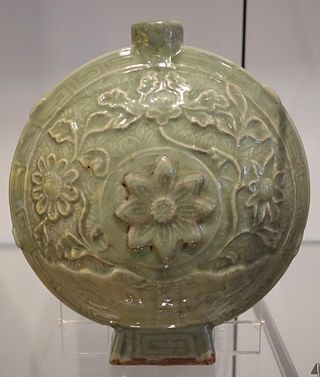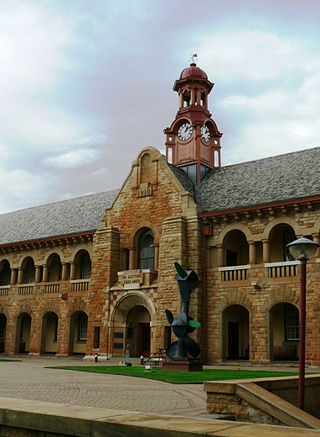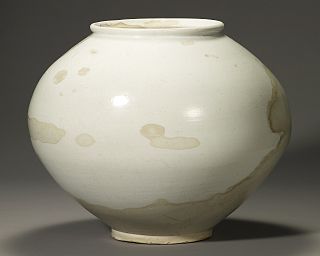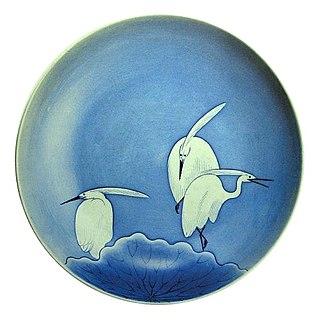
Longquan celadon is a type of green-glazed Chinese ceramic, known in the West as celadon or greenware, produced from about 950 to 1550. The kilns were mostly in Lishui prefecture in southwestern Zhejiang Province in the south of China, and the north of Fujian Province. Overall a total of some 500 kilns have been discovered, making the Longquan celadon production area one of the largest historical ceramic producing areas in China. "Longquan-type" is increasingly preferred as a term, in recognition of this diversity, or simply "southern celadon", as there was also a large number of kilns in north China producing Yaozhou ware or other Northern Celadon wares. These are similar in many respects, but with significant differences to Longquan-type celadon, and their production rose and declined somewhat earlier.

Pottery and porcelain is one of the oldest Japanese crafts and art forms, dating back to the Neolithic period. Types have included earthenware, pottery, stoneware, porcelain, and blue-and-white ware. Japan has an exceptionally long and successful history of ceramic production. Earthenwares were made as early as the Jōmon period, giving Japan one of the oldest ceramic traditions in the world. Japan is further distinguished by the unusual esteem that ceramics hold within its artistic tradition, owing to the enduring popularity of the tea ceremony. During the Azuchi-Momoyama period (1573-1603), kilns throughout Japan produced ceramics with unconventional designs. In the early Edo period, the production of porcelain commenced in the Hizen-Arita region of Kyushu, employing techniques imported from Korea. These porcelain works became known as Imari wares, named after the port of Imari from which they were exported to various markets, including Europe.

Celadon is a term for pottery denoting both wares glazed in the jade green celadon color, also known as greenware or "green ware", and a type of transparent glaze, often with small cracks, that was first used on greenware, but later used on other porcelains. Celadon originated in China, though the term is purely European, and notable kilns such as the Longquan kiln in Zhejiang province are renowned for their celadon glazes. Celadon production later spread to other parts of East Asia, such as Japan and Korea, as well as Southeast Asian countries, such as Thailand. Eventually, European potteries produced some pieces, but it was never a major element there. Finer pieces are in porcelain, but both the color and the glaze can be produced in stoneware and earthenware. Most of the earlier Longquan celadon is on the border of stoneware and porcelain, meeting the Chinese but not the European definitions of porcelain.

Korean ceramic history begins with the oldest earthenware from around 8000 BC. Throughout the history, the Korean peninsula has been home to lively, innovative, and sophisticated art making. Long periods of stability have allowed for the establishment of spiritual traditions, and artisan technologies specific to the region. Korean ceramics in Neolithic period have a unique geometric patterns of sunshine, or it is decorated with twists. In Southern part of Korea, Mumun pottery were popular. Mumun togi used specific minerals to make colors of red and black. Korean pottery developed a distinct style of its own, with its own shapes, such as the moon jar or Buncheong sagi which is a new form between earthenware and porcelain, white clay inlay celadon of Goryeo, and later styles like minimalism that represents Korean Joseon philosophers' idea. Many talented Korean potters were captured and brought to Japan during the invasions of Korea, where they heavily contributed to advancing Japanese pottery. Arita ware, founded by Yi Sam-pyeong opened a new era of porcelain in Japan. Another Japanese representative porcelain, Satsuma ware was also founded by Dang-gil Shim and Pyeong-ui Park. 14th generation of Su-kwan Shim have been using the same name to his grandfather and father to honor they are originally Korean, 14th Su-kwan Shim is honorable citizen of Namwon, Korea.

"Blue and white pottery" covers a wide range of white pottery and porcelain decorated under the glaze with a blue pigment, generally cobalt oxide. The decoration was commonly applied by hand, originally by brush painting, but nowadays by stencilling or by transfer-printing, though other methods of application have also been used. The cobalt pigment is one of the very few that can withstand the highest firing temperatures that are required, in particular for porcelain, which partly accounts for its long-lasting popularity. Historically, many other colours required overglaze decoration and then a second firing at a lower temperature to fix that.

SM Megamall, is a shopping mall located in Ortigas Center, Mandaluyong, Metro Manila, Philippines. It is the third largest shopping mall in the Philippines and the thirteenth largest in the world. SM Megamall is developed and operated by SM Prime Holdings. The mall occupies a land area of approximately 10 hectares and has a total floor area of 474,000 square meters (5,100,000 sq ft). The mall has a maximum capacity of 4 million people.

The Van Tilburg Collection is an art collection at the University of Pretoria that comprises 17th and 18th century furniture, paintings, Delft ceramics and other works of art, and includes the largest South African collection of Chinese ceramic objects. The oriental ceramic collection comprises 1699 pieces of earthenware, stoneware and porcelain dating from about 2000 BC until the early twentieth century.

Chinese ceramics are one of the most significant forms of Chinese art and ceramics globally. They range from construction materials such as bricks and tiles, to hand-built pottery vessels fired in bonfires or kilns, to the sophisticated Chinese porcelain wares made for the imperial court and for export.
Shin Sang-Ho is a Korean ceramicist. His works can be found in museums around the world especially the Shin Sang-ho Art Museum. He is the former Dean, College of Fine Arts at Hongik University in Seoul, and former Director of the Clayarch Gimhae Museum.

Vietnamese ceramics refers to ceramic art and pottery as a form of Vietnamese art and industry. Vietnamese pottery and ceramics has a long history spanning back to thousands of years ago, including long before Chinese domination, as archeological evidence supports.

The Miniatur Wunderland is, according to Guinness World Records, the largest model railway system in the world. It is located at the historic Speicherstadt in Hamburg and is one of the most popular and most visited sights in Germany.

A marble cake, or Marmor ) is a cake with a streaked or mottled appearance achieved by very lightly blending light and dark batter. Due to its zebra-striped pattern, it is also called zebra cake. It can be a mixture of vanilla and chocolate cake, in which case it is mainly vanilla, with streaks of chocolate. Other possibilities are strawberry or other fruit flavors, or cinnamon or other spices.

Moon jar is a type of traditional Korean white porcelain which was made during the Joseon dynasty (1392–1910). The Joseon white porcelain was adopted as imperial ware in the fifteenth century. Moon jars first appeared in the late seventeenth century and remained popular until the mid-eighteenth century. However, they were not nicknamed “moon jars” until the 1950s. The name comes from its shape and milky color of the glaze to resemble the coloration of the moon. This type of vessel is unique to the Joseon Dynasty and were never produced in China or Japan.

Hanoi Ceramic Mosaic Mural, or Hanoi Ceramic Road, is a ceramic mosaic mural along the walls of the Red River dike system in the city of Hanoi, northern Vietnam.

The Dubai Miracle Garden is a flower garden located in the district of Dubailand, Dubai, United Arab Emirates. The garden was launched on Valentine's Day in 2013. It occupies over 72,000 square metres (780,000 sq ft), making it the world's largest natural flower garden, featuring over 50 million flowers and 250 million plants.

Nabeshima ware is a type of Japanese pottery, specifically an unusually high-quality porcelain. It was produced in Ōkawachi kilns managed directly by the Saga Domain under the Nabeshima clan from the 17th to the 19th centuries. Imari ware and Arita ware were also under the control of the Saga Domain, and Nabeshima ware is sometimes regarded as a variant of Imari ware, as its kilns were located in what is now the city of Imari, Saga Prefecture Japan. The technique also differs from that of most Japanese porcelain, with the outlines of the pattern done in underglaze blue before the overglaze "enamelled" final decoration. Nabeshima ware was not made for sale, but for the specific use of the Nabeshima clan and as gifts for the Tokugawa shogunate and various daimyō. It was discontinued in 1871 with the abolition of the feudal domains, but the technique was revived as a modern craft by the Imaizumi Imaemon family, descendants of the master lineage, and has continued to the 21st century.

The Iran Mall is a very large shopping mall in Iran. With 1,950,000 m2 (21,000,000 sq ft), it is the world's largest shopping mall, beating the previous record holder The Dubai Mall. It is located in northwest Tehran, Iran, by Chitgar Lake.
Nguyễn Thu Thủy is a Vietnamese artist who currently works for the Hanoi New Newspaper. She is the current holder of the Guinness World Records for the Largest Ceramic Mosaic.

A flower carpet is a design made on the ground with flowers or flower petals arranged in patterns. Flower carpet events happen in many places around the world.
Kim Se-yong is a South Korean ceramist and C.E.O of Sechang Artistic Ceramic Institute. He is known for his celadon style on ceramics based upon the traditional Goryeo wares. Kim was a former Professor of Ceramic Art at Chungkang College of Cultural Industries, and currently resides and works in Icheon, South Korea.

















